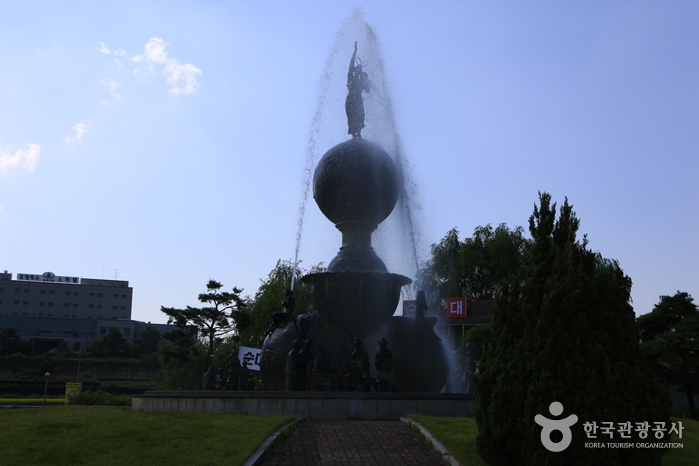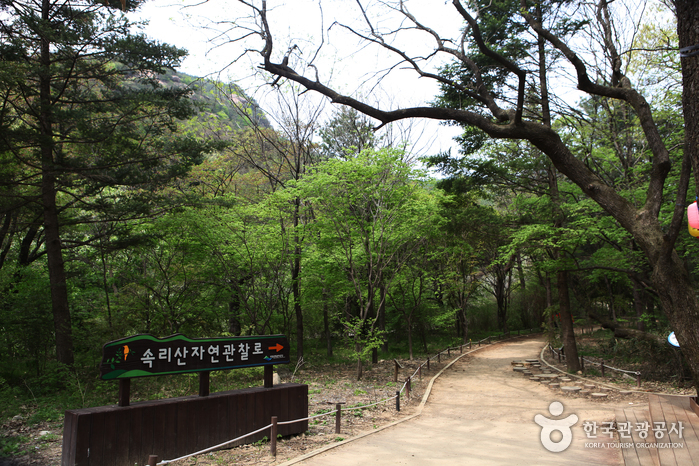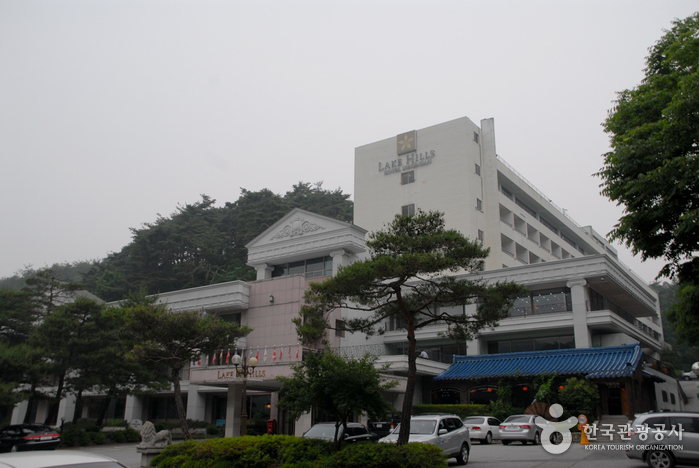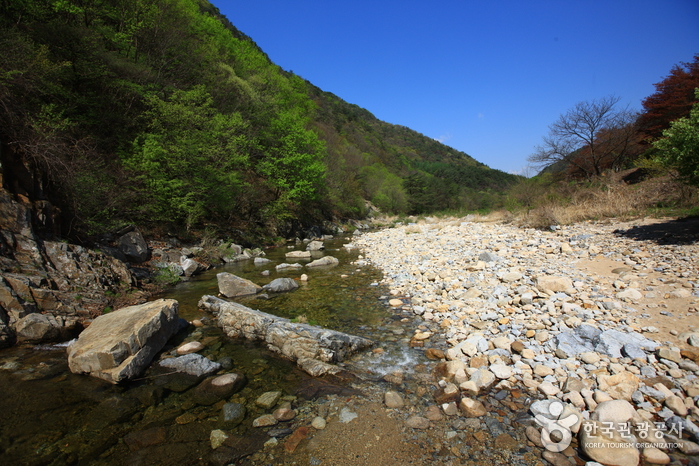Chojeongyaksu Mineral Spring (초정약수)
13.9 Km 23403 2022-07-29
Chojeong-ri, Cheongwon-gu, Cheongju-si, Chungcheongbuk-do
+82-43-201-2042
Located approximately 16 kilometers northeast of Cheongju City, Chojeongyaksu Mineral Spring is acknowledged as one of the three major mineral springs in the world. Chojeong Mineral Spring was discovered around 600 years ago and became nationally known ever since as the source of naturally carbonated water that has a piquant and cool taste. It is said that King Sejong (1397-1450, reign 1418-1450) visited the springs in 1444 and stayed here for 60 days to treat an eye infection. The daily yield of carbonated water here is 458 tons, which is used for producing natural soda drinks. There are presently two mineral water plant facilities in the area. The healing effects of Chojeongyaksu Mineral Spring are presumed to come from the abundant radium contained in the water, which is effective in treating eye infections and skin ailments.
Chojeong Haenggung [Korea Quality] / 초정행궁 [한국관광 품질인증]
13.9 Km 8 2023-10-27
851 , Chojeongyaksu-ro, Cheongwon-gu, Cheongju-si, Chungcheongbuk-do
+82-43-270-7332
Chojeong Haenggung is a hanok stay and hanok experience center in Chojeong Culture Park, Cheongju, Chungcheongbuk-do. The house has a historic royal connection, as King Sejong stayed here for some months in 1444 while being treated for an eye problem. There are 12 guestrooms, all with an underfloor-heated ondol room and either a daecheongmaru (large wood-floored hall) or a numaru (raised wooden floor space). All rooms have a bathroom and toilet. Cooking is not possible, but there’s a microwave oven and kettle for preparation of instant meals. There are discounts for Cheongju residents.
Sanmagi Old Trail (산막이옛길)
14.2 Km 23072 2024-02-15
88 Sanmagiyet-gil, Chilseong-myeon, Goesan-gun, Chungcheongbuk-do
+82-43-832-3527
Sanmagi Old Trail in Oesa-ri, Chilseong-myeon, within Goesan-gun of Chungcheongbuk-do, stretches over a picturesque 3.93 km. It connects to the serene Sanmagi Village, nestled in the mountains. This trail has been thoughtfully restored, tracing contour of an ancient road, a faint remnant of times gone by. Offering stunning vistas of mountainous terrain, flowing waters, and lush forests, the trail represents one of the most enchanting aspects of Goesan’s landscape. Its true value lies in the unspoiled natural ecosystem preserved around the dam. The old mountain path, gently redeveloped with eco-friendly techniques alongside the Goesan Dam, harmoniously complements the tranquil waters of the dam’s lake, presenting a glimpse of Korea’s natural splendor. A walk along this trail, with the scent of the forest and the soft caress of a river breeze, invites a profound connection with nature in its purest form..
Songnisan Special Tourist Zone (속리산 관광특구)
15.8 Km 4172 2022-08-22
405, Beopjusa-ro, Boeun-gun, Chungcheongbuk-do
+82-43-540-3393
With Songnisan National Park at its center, Songnisan Special Tourist Zone offers picturesque scenery and cozy resorts. At 1,058 meters above sea level, Songnisan Mountain is one of the 8 scenic wonders in Korea, and its steep peaks and deep valleys create a fascinating view. A variety of hiking trails that set out from Beopjusa Temple offer superb mountain scenery from every angle.
A tourism complex around Songnisan National Park offers various types of accommodations, and the area's attractions, such as Beopjusa Temple, Seowongyegok Valley, Mansugyegok Valley and Solhyang Park are not to be missed. In fact, the mountain is a habitat for rare animals and plants, including flying squirrels and Berchemia Berchemiaefolia, and is called a “treasure house of natural resources.”
The convenient accessibility should be noted as well. The highway between Dangjin and Yeongdeok goes through the zone, and it takes only 30 minutes from Cheongju International Airport. This helps foreign tourists from China, Taiwan and Singapore as well as Korean visitors to easily access the zone.
A variety of events, including the Songni Festival, the Songnisan Maple Music Festival and the Songnisan Hiking Festival, are held every year, and the largest number of tourists visit in autumn to appreciate a view of the mountain tinged with red.
* Current State of Songnisan Special Tourist Zone
1) Districts Covered: Areas around Sangpan, Jungpan, Galmok and Sanae-ri, Songnisan-myeon, Boeun-gun, Chungcheongbuk-do
2) Area: 43,745,528 ㎡
Boeun Beopjusa Temple [UNESCO World Heritage] (보은 법주사 [유네스코 세계문화유산])
15.8 Km 39256 2021-10-23
405, Beopjusa-ro, Boeun-gun, Chungcheongbuk-do
+82-43-543-3615
Built in 553 during the 14th year of Silla King Jinheung's reign, Beopjusa Temple is located on Songnisan Mountain. However, many of the original buildings were destroyed during the Imjin War (1592-1598), with the current structures having been rebuilt in 1624. The temple features many beautiful and important Buddhist relics and artworks, centered around the main hall, Daeungbojeon Hall.
Lake Hills Hotel Songnisan (레이크힐스 호텔 속리산)
16.1 Km 12940 2021-02-19
305, Beopjusa-ro, Boeun-gun, Chungcheongbuk-do
+82-43-542-5281
Lake Hills Hotel Songnisan is set against the lush natural surroundings of Songnisan National Park. With comfortable rooms, a banquet hall that can accommodate up to 400 people, and six smaller conference rooms, the hotel regularly hosts corporate seminars and large family gatherings alike.
Kyunghee Sikdang (경희식당)
16.1 Km 24482 2024-02-26
11-4, Sanae 7-gil, Songnisan-myeon, Boeun-gun, Chungcheongbuk-do
Kyunghee Sikdang is a Korean table d'hote restaurant with 70 years of history, located at the entrance to the Beopjusa Temple in Songnisan Mountain. The dishes are prepared with ingredients sourced from Songnisan Mountain, vegetables grown by the restaurant, and in-house sauces. They come with nearly 40 side dishes, such as sogogi pyeonyuk (boiled beef slices), dureup namul (fatsia shoot salad), gosari (bracken), gam jangajji (pickled persimmons), ssari beoseot (coral mushroom), meowi namul (butterbur salad), pyogojeon (pan-fried battered golden oak mushrooms), bam jorim (braised chestnuts), and deulkkae songi twigak (young perilla branch chips). The restaurant’s mustard sauce and gangdoenjang (seasoned soybean paste) are made according to its secret recipe.
Deongnim Sanchae Sikdang (덕림산채식당)
16.2 Km 22871 2024-03-18
287, Beopjusa-ro, Songnisan-myeon, Boeun-gun, Chungcheongbuk-do
043-543-4846
Deongnim Sanchae Sikdang is a tile-roof restaurant located next to the parking lot of Songnisan Mountain’s Beopjusa Tourist Complex. It serves sanchae jeongsik (wild vegetable dish set menu) made with mushrooms and vegetables sourced from Songnisan Mountain, deodeok gui jeongsik (grilled deodeok set menu), beoseot jjigae jeongsik (mushroom jjigae set menu), sanchae bulbaek jeongsik (wild vegetable and bulgogi set menu), bibimbap, and haemul pajeon (seafood and green onion pancake). The restaurant is close to tourist sites like Songnisan Sculpture Park, Orisup Trail, and Beopjusa Temple.
Café Forecyan (카페 포레시안)
17.1 Km 0 2024-02-23
643 Sanseong-ro, Sangdang-gu, Cheongju-si, Chungcheongbuk-do
Café Forecyan is located near the Sangdangsanseong Fortress, renowned for being a pleasant drive away. This spacious bakery-café is celebrated for its picturesque pond photo spot and captivating ice fountain during winter. Guests can indulge in a variety of delicious options such as coffee, yogurt, ice cream, tea, and child-friendly drinks. The menu also features a Fruits Party platter with 5-6 different fruits, sogeum baguette (salted baguette), fruits pie, and cake, all popular among visitors. The café is surrounded by a lush front yard filled with grass and flowers, and a serene backyard adorned with birch trees and hydrangeas, offering splendid views for a delightful visit.
Ssanggok Valley (쌍곡구곡)
17.4 Km 6035 2022-08-31
242, Ssanggok-ro, Chilseong-myeon, Goesan-gun, Chungcheongbuk-do
+82-43-542-5267
Ssanggok Valley, which is located in Chilseong-myeon, Goesan-gun, is 10.5km long stretching from Ssanggok village to Jesurijae.
The valley is surrounded by Bobaesan Mountain, Gunjasan Mountain and Bihaksan Mountain and clear water flows all year down the walls of a series of unique rock formations.
Thanks to its scenic beauty, many Confucian scholars used to visit here to enjoy literature and nature.
Ssanggok Valley is composed of nine valleys and each has its own unique atmosphere.
The first valley, Holongso, flows into a swamp area with many old pine trees nearby creating a picturesque view. The second valley is called Sogeumgang and it is said that its appearance changes with every season. Tteokbawi (rice cake rock) Valley gets its name from the shape it takes on, which is like a sliced rice cake. Similar to the first valley, Munsuam Valley, the fourth valley also has water flowing over uniquely shaped rocks with many old pine trees and flora. The fifth valley has quite a view of parallel rocks on both sides, while the sixth valley offers magnificent vistas of water flowing into a pool formed by the rocks. The water cascading down a huge boulder is said to look like the pleats of a woman’s skirt unfolding at the seventh valley. The eighth valley gathers water into a pond shape from the waterfall; legend says that fairies bathe here. The ninth valley is wide and refreshingly cool even during the hottest summer months.

![Chojeong Haenggung [Korea Quality] / 초정행궁 [한국관광 품질인증]](http://tong.visitkorea.or.kr/cms/resource/20/3021620_image2_1.jpg)


![Boeun Beopjusa Temple [UNESCO World Heritage] (보은 법주사 [유네스코 세계문화유산])](http://tong.visitkorea.or.kr/cms/resource/58/1731558_image2_1.jpg)


 English
English
 한국어
한국어 日本語
日本語 中文(简体)
中文(简体) Deutsch
Deutsch Français
Français Español
Español Русский
Русский